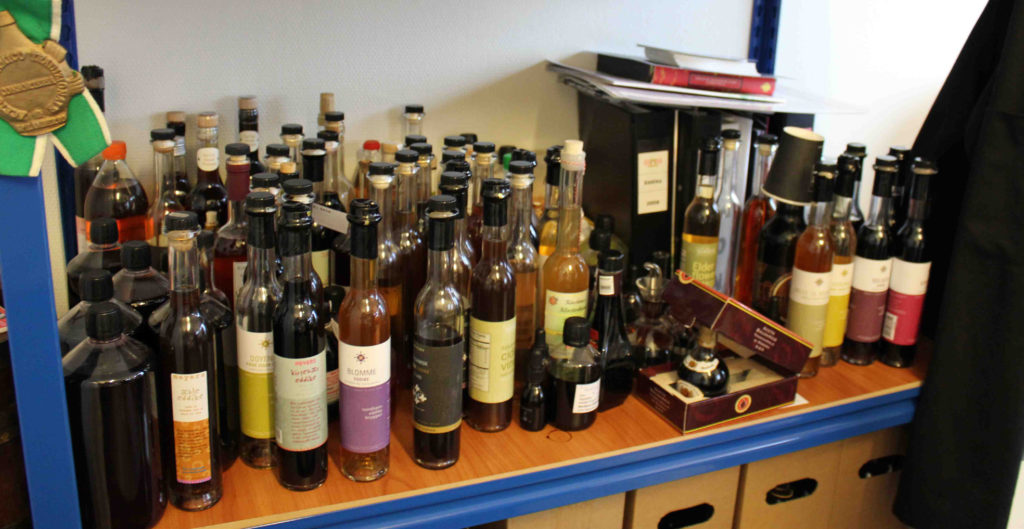by Ben Reade.

The principle result of acetous fermentation is vinegar. Vinegar, frequently considered a poor cousin in the realm of fermented foods can, when made with the right knowledge and aims, produce a high quality and expensive product (sometimes reaching prices of US$1/ml). Flavours of vinegars available on the market are generally quite limited and for this reason a need was felt at NFL to develop delicious vinegars with novel flavour combinations. For this reason, and the ease and high success rate of this type of fermentation, vinegars have become a favorite area of investigation for NFL. Historically vinegar has been used principally as food preservative, medicine and flavouring agent as well as a cleaning product, mordant or for odor removal. (Diggs, 1989)
Many acetic acid bacteria (AAB) are fastidious, meaning that they can be difficult to culture in laboratory situations. For this reason, as well as the complexity, fast evolutionary rate and immense size of the group has made taxonomic classification difficult in the past. Recently however, techniques of culture independent methods, such as 16S rRNA and DNA-DNA hybridization studies as well as comparative studies of phylogenic trees, physiological and morphological characteristics are causing rapid developments in classification. (Gullo and Giudici, 2009, Giraffa and Carminati, 2008)
AAB fermentation produces acetic acid, colloquially known as vinegar. Until 1935 the Acetobacteraceae family was categorized by their ability to metabolize differing nutrients. AAB capable of oxidizing (breaking down) ethanol into acetic acid in aerobic conditions are the most ubiquitous and can be found airborne in most places. There are ten genera to be included in the family of Acetobacteraceae (AAB) They are, Acetobacter, Acidomas, Glucanacteoobacter, Glucanobacter, Granulibater, Kozakia, Frateuria, Neosaia, Saccharibacter and Swaminathania (Gullo and Giudici, 2009).
Simple European Vinegars
Classic vinegars as we know them in the West are made by a number of different methods. These can basically be divided into two groups: slow and traditional techniques where attaining a finished vinegar may take from one month to many years; innovative processes which make faster processes where vinegar may be ready from alcoholic vinegar stock in as little as six hours.
Before describing some of the commonly used methods, it is important to explain the basics of vinegar production. In sugar rich, easily fermentable fruits a two stage fermentation is employed, Firstly yeasts transform sugars within the juice into alcohol. The second stage of the process, and the first performed by AAB is the transformation of ethanol alcohol into acetic acid.
Ethanol + O2 (arrow) Acetic Acid + Water
As the AAB requires oxygen to oxidize ethanol into acetic acid, the airlock used for alcoholic fermentation is no longer necessary and the presence of air, and oxygen contained within the air, becomes very important. AAB are facultative aerobes, meaning that they must have oxygen to thrive
Another factor to consider with AAB is that they produce acetic acid, as with most microorganisms, they are adapted to living in solutions rich in their metabolites. For this reason, AAB will proliferate much more easily if some vinegar is mixed in with the alcoholic ferment, thereby acidifying the ‘wine’. This is normally carried out using an older batch of vinegar made from the same source. If this is done with unpasteurised vinegar this is also a means by which to inoculate the ‘wine’ with the correct AAB strains.
Over the next few posts we’ll be looking at various methods to make vinegar, describing along the way a few successful experiments that you can try too.
Bibliography
Diggs, L.J. (1989) Vinegar, the user friendly standard text guide to appreciating, making and enjoying vinegar, iUniverse, USA.
Gullo, M. and Giudici, P. (2009) Acetic acid bacteria: taxonomy from early descriptions to molecular techniques, in Solieri, L. & Giudici, P. (eds), Vinegars of the World, pp. 41-60, Springer-Verlag Italia S.r.l. Milan, Italy.
Giraffa, G and Carminati, D. (2008) Molecular techniques in food fermentation: principles and applications, in Cocolin, L. and Ercolini, D. (eds) Molecular techniques in the microbial ecology of fermented foods, Springer Science and Business Media LCC, New York.
About the author
My Name is Ben Reade, I’m a chef from Edinburgh, Scotland, and for the past 3.5 years I have been studying at The University of Gastronomic Sciences in Pollenzo, Italy. For my final thesis, I came to Nordic Food Lab to research many subjects where my varied interests inerlaced with those of the Lab. The research arose out of time spent at the Nordic Food Lab between 29 September and 22 December 2011. The aim is to describe NFL’s current research to both chefs and non-specialized readers, explaining and coding the creative and scientific methodologies employed during the research at NFL, exploring their application in food experimentation and innovation. Over the next month or so I will be breaking down this thesis into manageable blog-style chunks, this is chunk 13ish of around 25 I hope you find it interesting. If you want to ask me any questions directly, I’m contactable on Twitter @benreade. In general
